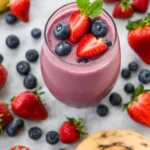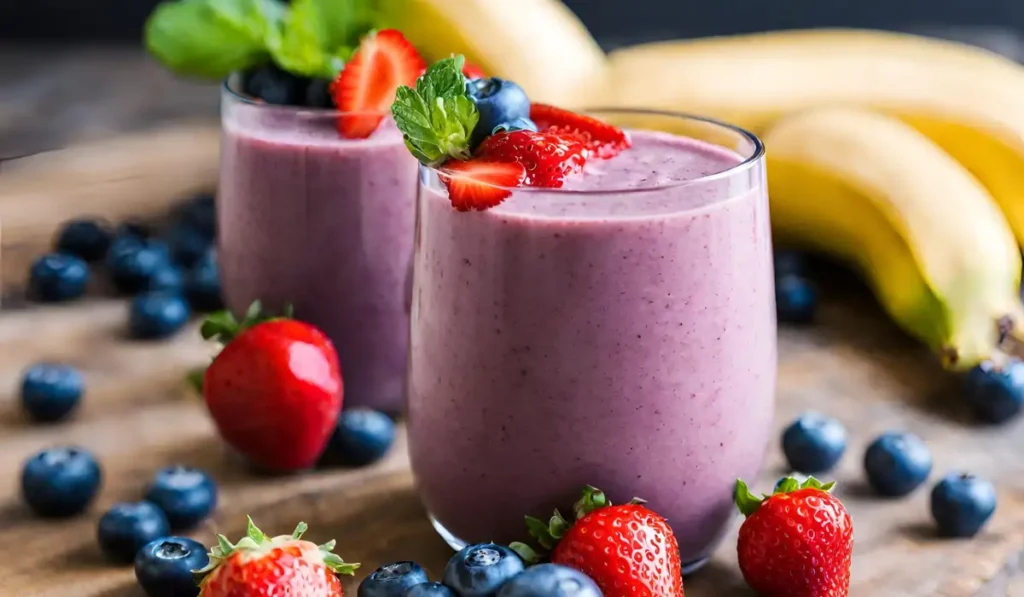Introduction to Smoothies
Smoothies have become a staple in the diet of health-conscious individuals worldwide, offering a delicious way to consume a variety of fruits, vegetables, and other nutrients. The concept of blending fruits with ice, milk, or yogurt dates back to the early 20th century, but it wasn’t until the 1960s and 1970s that smoothies began to gain popularity, especially in the United States, as part of the health food movement. Today, they are celebrated not only for their convenience and taste but also for their nutritional benefits.
The importance of fruit smoothies in a balanced diet cannot be overstated. Packed with vitamins, minerals, and fiber, they offer an excellent way to boost your daily fruit intake. According to the U.S. Department of Agriculture, adults should consume two to three cups of fruits per day as part of a healthy eating pattern. Smoothies, especially those made with a mix of fruits, can help meet this goal, providing essential nutrients that support overall health.
One particularly nutritious and delicious combination is the banana, blueberry, and strawberry smoothie. This blend not only tastes great but also offers a multitude of health benefits:
- Bananas are a great source of potassium and dietary fiber, aiding in digestion and heart health.
- Blueberries are packed with antioxidants, which can protect the body from free radicals and support the immune system.
- Strawberries are high in vitamin C and manganese, promoting skin health and aiding in the reduction of inflammation.
Including a banana, blueberry, and strawberry smoothie in your diet can be a delightful way to enjoy a variety of these health benefits. For more on the nutritional value of blueberries and bananas, the Harvard T.H. Chan School of Public Health provides extensive insights into how these fruits can contribute to a balanced diet.
The Perfect Banana, Blueberry, and Strawberry Smoothie Recipe

Creating the perfect banana, blueberry, and strawberry smoothie is an art that combines taste, nutrition, and simplicity. This smoothie is not just a treat for the taste buds but also a powerhouse of nutrients. Here’s how to make this delicious and healthy beverage right in your kitchen.
Ingredients List:
- 1 ripe banana
- ½ cup frozen blueberries
- ½ cup frozen strawberries
- 1 cup milk or almond milk (for a dairy-free option)
- A tablespoon of honey or maple syrup (optional, for sweetness)
Step-by-Step Preparation Instructions:
- Start by peeling the banana and cutting it into chunks.
- Place the banana pieces, frozen blueberries, and frozen strawberries into a blender.
- Pour the milk or almond milk over the fruits. Add honey or maple syrup if you prefer a sweeter taste.
- Blend on high until the mixture is smooth and creamy. If the smoothie is too thick, you can add a little more milk to reach your desired consistency.
- Pour the smoothie into a glass and enjoy immediately for the best taste and nutrient retention.
Nutritional Information: This smoothie is not only delicious but also incredibly nutritious. Bananas provide a good dose of potassium and fiber, blueberries are known for their high antioxidant levels, and strawberries bring a wealth of vitamin C to the mix. Together, they create a smoothie that’s both energizing and health-promoting. For a detailed breakdown of the nutritional content, including calorie count and vitamin percentages, visiting resources like the USDA’s FoodData Central can offer comprehensive insights.
By following this simple recipe, you can enjoy a smoothie that’s perfect for breakfast, as a post-workout snack, or anytime you need a refreshing boost. Not only will it satisfy your sweet cravings, but it will also contribute to your daily nutritional goals, making it a win-win for taste and health.
Benefits of Each Ingredient

Smoothies are a fantastic way to enjoy the synergistic effects of combining various fruits, each bringing its unique set of nutrients and health benefits. Let’s delve into the benefits of bananas, blueberries, and strawberries, and discover how these fruits complement each other nutritionally.
- Health benefits of bananas:
- Bananas are renowned for their high potassium content, which is vital for maintaining healthy blood pressure and heart function. They also provide a significant amount of dietary fiber, contributing to digestive health and aiding in the prevention of constipation. Additionally, bananas offer vitamin C, vitamin B6, and magnesium, supporting the immune system, brain health, and muscle function.
- Health benefits of blueberries:
- Blueberries are among the highest antioxidant-rich foods, containing powerful phytoflavinoids, including anthocyanins, which are responsible for their deep blue color. These antioxidants help combat free radicals in the body, reducing the risk of chronic diseases and inflammation. Blueberries also contribute to brain health, improving memory and cognitive function, as highlighted in studies referenced by the National Institutes of Health.
- Health benefits of strawberries:
- Strawberries are an excellent source of vitamin C, surpassing even oranges in concentration. They are also rich in antioxidants and plant compounds, which can decrease heart disease risk, control blood sugar, and have anti-cancer properties. Strawberries provide a good fiber source, aiding in digestion and contributing to satiety, which can be beneficial for weight management.
- How these fruits complement each other nutritionally:
- Combining bananas, blueberries, and strawberries in a smoothie creates a nutrient-dense beverage that can serve as a substantial snack or a complement to a meal. The mix of vitamins, minerals, and antioxidants provides comprehensive health benefits. The fiber from these fruits supports digestive health, the potassium from bananas aids in cardiovascular health, the antioxidants in blueberries support brain function and reduce inflammation, and the vitamin C in strawberries boosts the immune system. This combination also ensures a broad coverage of nutrients essential for skin health, energy metabolism, and overall wellness.
Together, bananas, blueberries, and strawberries make a smoothie blend that’s not just delicious but also incredibly beneficial for health.
Customizing Your Smoothie

Creating the perfect smoothie means adapting the recipe to fit your dietary preferences and nutritional needs. Let’s explore how to customize your banana, blueberry, and strawberry smoothie with different liquids, the addition of superfoods, and tips to make it more filling.
- Variations with milk, yogurt, and alternative milks:
- To adjust the creaminess and taste of your smoothie, consider using different types of milk. Cow’s milk provides a rich source of calcium and protein, while plant-based milks like almond, soy, or oat milk offer unique flavors and benefits, such as lower calorie content and no dairy allergens. Adding yogurt can enhance the texture and add probiotics for gut health. Each option can subtly change the flavor profile and nutritional content of your smoothie, catering to various dietary needs and preferences.
- Adding superfoods and supplements:
- Elevate the nutritional value of your smoothie by incorporating superfoods and supplements. Options like chia seeds, flaxseeds, or hemp seeds add omega-3 fatty acids, fiber, and protein, making your smoothie even more beneficial. Protein powders, spirulina, or matcha powder can also be mixed in for an extra boost of nutrients. These additions not only enhance the health benefits but also contribute to the smoothie’s texture and taste.
- Tips for making your smoothie more filling:
- To increase the satiety factor of your smoothie, consider adding ingredients that are high in fiber and protein. Oats or nut butters are excellent for making your smoothie more filling, providing the energy you need to start your day or recover from a workout. Additionally, avocados can add healthy fats, contributing to a creamier texture and increased fullness.
By customizing your smoothie with these variations and additions, you can create a beverage that not only tastes great but also aligns with your health goals and dietary preferences.
Common Mistakes and Solutions

Making a perfect smoothie might seem straightforward, but a few common pitfalls can affect the taste and texture. Here are some mistakes to avoid and solutions to ensure your smoothie turns out great every time.
- Overblending:
- Overblending can lead to a runny texture and can also cause your smoothie to warm up. Solution: Blend your smoothie just until all ingredients are combined and smooth, which typically takes no more than 30 to 60 seconds.
- Not using the right ratios:
- Too much or too little of any ingredient can throw off the balance of your smoothie. Solution: Start with a basic ratio of 2 cups fruit to 1 cup liquid, adjusting as needed for taste and consistency.
- Choosing the wrong type of liquid base:
- The base can significantly impact the flavor and caloric content of your smoothie. Solution: Choose a liquid base that complements the flavors of your fruits and meets your dietary needs, whether it’s milk for creaminess and protein or water for a lighter option.
Smoothie Preparation and Storage Tips

To enjoy the best taste and nutritional benefits, following best practices for smoothie preparation and storage is essential.
- Best practices for smoothie preparation:
- Use frozen fruits to achieve a thick and cold smoothie without needing ice, which can dilute the flavor. Preparing your ingredients in advance can save time and ensure you have everything ready to go.
- How to store your smoothie for freshness:
- If you can’t drink your smoothie immediately, store it in an airtight container in the refrigerator. It’s best consumed within 24 hours to maintain freshness and nutrient content.
- Can you make your smoothie ahead of time?:
- Yes, you can prepare your smoothie ahead of time. For the best results, blend your smoothie and store it in the fridge overnight in an airtight container. Give it a good shake or stir before drinking, as separation may occur.
By avoiding common mistakes and following these preparation and storage tips, you can ensure your smoothies are always delicious and nutritious. For more detailed information on smoothie preparation, Consumer Reports offers guides and tips on choosing appliances and techniques for making the perfect smoothie.
FAQs
Smoothies made from strawberry, blueberry, and banana are not only delicious but also packed with nutrients that can benefit your health in numerous ways. Here are some frequently asked questions about this delightful combination:
- What are the benefits of a strawberry, blueberry, and banana smoothie?
- This smoothie is a nutritional powerhouse, offering a rich source of dietary fiber, vitamins, and antioxidants. Specifically, it supports heart health, aids in digestion, boosts the immune system, and can help in managing weight. For more detailed benefits, the Mayo Clinic offers insights into how antioxidants from blueberries and other fruits can impact your health.
- Can you use frozen berries in a smoothie?
- Absolutely! Frozen berries are not only convenient but also help to give your smoothie a thick and creamy texture. They’re as nutritious as fresh berries and ensure your smoothie is refreshingly cold.
- Is it OK to eat blueberries and bananas together?
- Yes, it’s perfectly fine to eat blueberries and bananas together. This combination is not only safe but also beneficial, providing a balanced mix of nutrients and flavors that complement each other well.
- What two fruits go well together in a smoothie?
- Besides strawberries, blueberries, and bananas, mango and peach make a great pairing in smoothies for a tropical flavor. Their sweetness and smooth texture blend well, creating a refreshing and nutrient-rich drink.
These FAQs underscore the versatility and health benefits of incorporating a variety of fruits into your diet through smoothies. For additional tips on creating the perfect fruit smoothie, resources like Healthline can offer a wealth of information on combinations and preparation techniques that maximize both taste and nutritional value.
Print
Banana Blueberry And Strawberry Smoothie Recipe
5 Stars 4 Stars 3 Stars 2 Stars 1 Star
No reviews
- Author: karma
- Total Time: 5 minutes
- Yield: 1 serving
Description
This banana, blueberry, and strawberry smoothie is a vibrant, delicious blend of sweet fruits and refreshing flavors, making it the perfect nutritious drink for breakfast or a snack. It’s packed with vitamins, antioxidants, and fiber to give you a healthful boost any time of the day.
Ingredients
- 1 ripe banana
- ½ cup frozen blueberries
- ½ cup frozen strawberries
- 1 cup milk or almond milk
- Optional: 1 tablespoon honey or maple syrup for sweetness
Instructions
- Peel and chop the banana into chunks.
- Combine the banana, frozen blueberries, and strawberries in a blender.
- Add the milk (or almond milk) and optional sweetener.
- Blend on high until smooth and creamy. Adjust the milk if necessary to achieve your desired consistency.
- Serve immediately and enjoy!
Notes
- For a vegan version, use almond milk and maple syrup as sweeteners.
- Add a scoop of protein powder or a tablespoon of chia seeds for an extra nutrient boost.
- Prep Time: 5 minutes
- Cook Time: 0 minutes
- Category: Beverage
- Method: Blending
- Cuisine: American
Nutrition
- Serving Size: Per serving, based on using unsweetened almond milk and no optional sweetener
- Calories: 200 kcal
- Sugar: 29g (natural sugars from the fruits)
- Fat: 1.5g
- Carbohydrates: 46g
- Fiber: 6g
- Protein: 3g










